
Putting back the figs and other fruits
I think it's fairly reasonable to assume that Sassafras had a fair smattering of figs and probably more than just the 2 species I'm starting off with.
My reasoning goes like this.
There are very mature figs of both species on the Manning River and the Comboyne Plateau, there plenty of quite mature Port Jackson Figs bordering Sassafras, there are Morton Bay figs bordering Sassafras, there are seedling size specimens of both still here but struggling with Wallabies, fire and frost.
Why do I want to put back figs? I'm guessing that the Bats and other fig eating avians will bring in other plant species from where they were feasting in the last hour or so. Sassafras is probably well under 15 minutes flying time from Comboyne and maybe less then 30 minutes from the Manning River and lots of other places. If I can put back cover story species other upper, middle and under storey species that are frost tender should follow. I know my ground planted figs will not be as tall as those starting out as epiphytes but 30 or 40 metres is still a reasonable size tree.
OK, the previous few paragraphs were written a while ago now, I realise we also had a lot of other fruit bearing trees, bushes and vines. I'm told by one bloke who has lived on and off along Mooral Creek for over 80 years that in his younger days there used to be big flocks of the White Headed Pidgeons we have, now they are maybe a flock of perhaps 20 to 30 at most.
Now I sometimes think of Sassafras as the land of Cryptocarya or, to add one more species, the land of the Lauraceae. Not actually a lot of species, just everywhere and most have quite a few large specimens and they can occur in groves. Perhaps the most notable of these groves is an almost pure stand of the smallest species, Cryptocarya rigida, beneath mature Eucalyptus microcorys. I found while making my way down a drier North South ridge from the northern fence line after clearing lantana. The C. rigida then were all around 6 to 8 metres tall, not densely packed but there was very little in the way of ground cover around them, very easy walking, rather park like I guess.
About 5 minutes below this ridge and to the west is a grove of perhaps 10 or so C. glaucescens, some would be getting on for 90 cm in diameter. I don't know whether C. glaucescens is fire resistant but it is certainly frost resistant, that would help to explain why it is moderately common as a larger tree in recent regrowth amongst privett.
Then there are the Pepperberrys that are around in various places, C. obovata. Starting to poke their heads up and giving rise to offspring. C. meisneriana is not as common across Sassafras, though easy enough to find along the upper reaches of our internal creek.
Endiandra muelleri is another of the Lauraceae that can be found in a variety of locations though not as common as the first 2 I've described but quite striking looking up through the veined leaves.
After this little ditty I now think there is another Cryptocarya that I have not identified, usually multi trunked (as C. rigida usually is) or a very large varse shaped bush to about 10 to 12 metres.
The Lauraceae seem to germinate naturally on Sassafras fairly easily, for some species a cage can help in that first 12 months to speed them through that first difficult metre.
Syzygium is another common genus that germinate everywhere, only 3 species but maturing and mature speciments are quite common.
Dollarbirds go beserk over a tasty Acronychia oblongifolia, when fruiting is heavy from a distance it looks like it is covered in snow. Usually only a small tree but also useful along boundaries because cattle don't seem to like the foliage and it is fairly dense, keeping the light and weeds out.
The other reason for wanting to put back a decent cover storey is the lower light levels will stop the Small and Large Leaf privets regenerating. There is minimum light level they need, I don't know what it is but I've seen this happen in a regen project I worked on during lunch breaks on creek valley leading into Sydney Harbour some years ago, before we moved to Sassafras. If you can't see the sky at all you have a closed canopy, the seedlings don't germinate, I'm also told they are only viable for 2 or maybe 3 years, there is hope! There are some places on Sassafras where this is already happening.
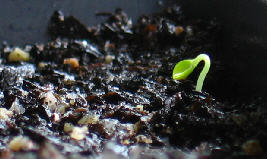


This current batch of Ficus macrophylla seedlings came from seeds scraped off a timber seat in Wingham, underneath a rather large Ficus. In total probably equivalent to between 6 to 10 fig fruits, some as Bat poo and some as soft fig splatter after falling a long way. Collected in March 2007, planted 4 March 2007 the first seedlings appeared 8 days after planting, 12 March 2007.
During the next couple of days more appeared.
After about 9 days probably 40% of the germination happened, many more did come up. Germination was probably complete after 20 days with something close to a couple of hundred seedlings all up. A day after the photos above and already they are heading towards the light.
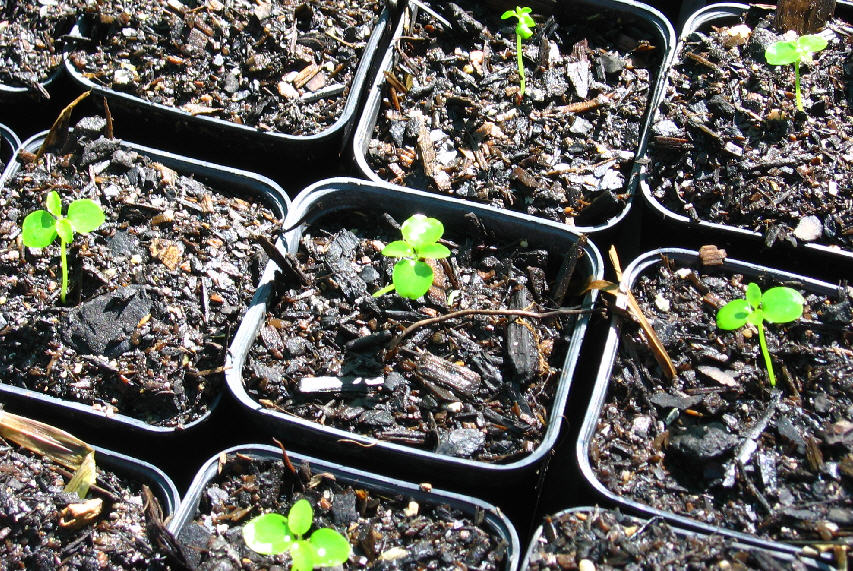
A few weeks later, 2 April 2007, in the shade house potted up, the first pair of true leaves have appeared.
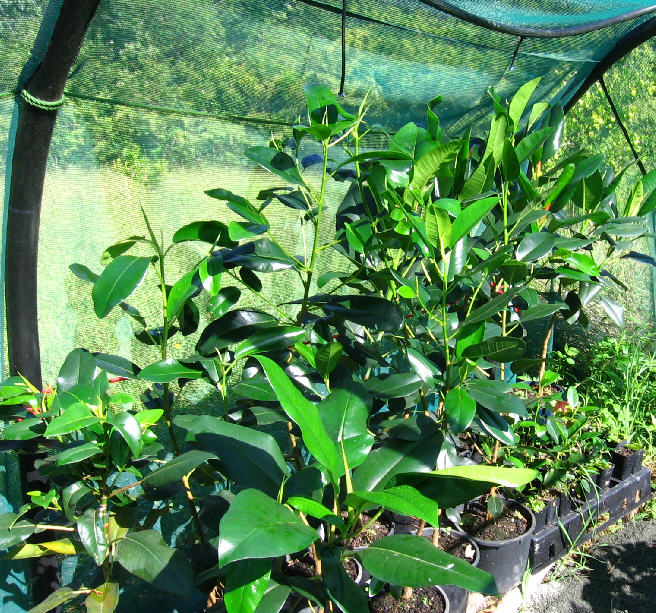
These are the final remnants of previous years propagation. My aim this year is to get the Ficus macropyhlla seedlings to the plant out size, over 900mm tall, preferably 1 metre, by mid December 2007, about 9 months after germination. The very tallest are 1 metre tall. Given the rate of growth of those in the 200mm pots this is extremely likely, these are the stragglers. I only transplanted the larger ones from tubes in October and started feeding them in December, when they took off. It seems to me that most Rainforest species are fairly gross feeders, most are not averse to higher levels of Phosphorus unlike the later Proteaceae from drier times that evolved in older soils.
In the photo below I can see maybe 5 Morton Bay Figs. Most are Port Jackson Figs, they were propagated from a small handful of figs left over on the ground from one tree maybe 300 metres away directly behind these figs up on the other side of the valley, photo to follow. The week before we collected them all trees were heavy with figs, left it just few days too late, the bats had their feast. Still we had 2 seed trays absolutely chokers with seedlings, guesstimate of 400 plus seedlings. The last of them will potted on from 150mm to 200mm pots this Spring (September 2007). They have been around for 2 or 3 years, dying back each winter in their pots. This year they get planted!
The same figs as above, 8 July 2007. I don't expect them to grow too much until the warmer weather returns, late August or September.
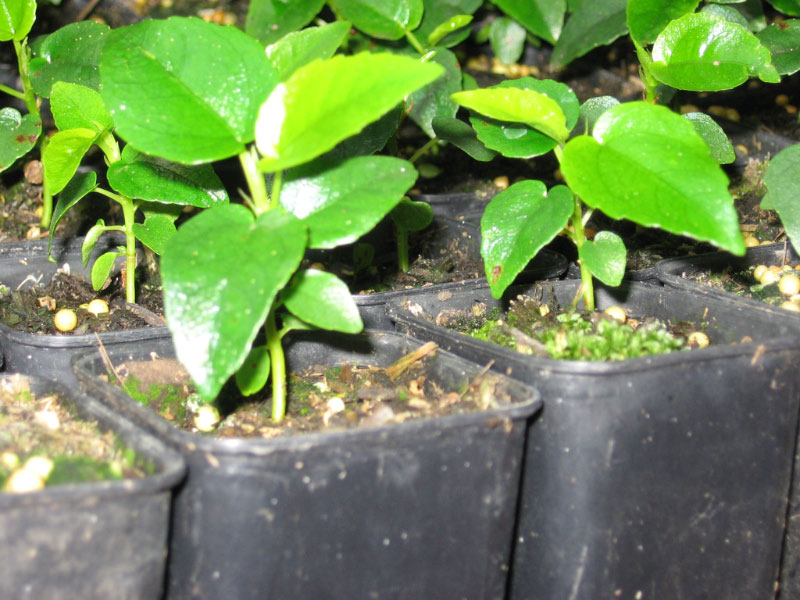
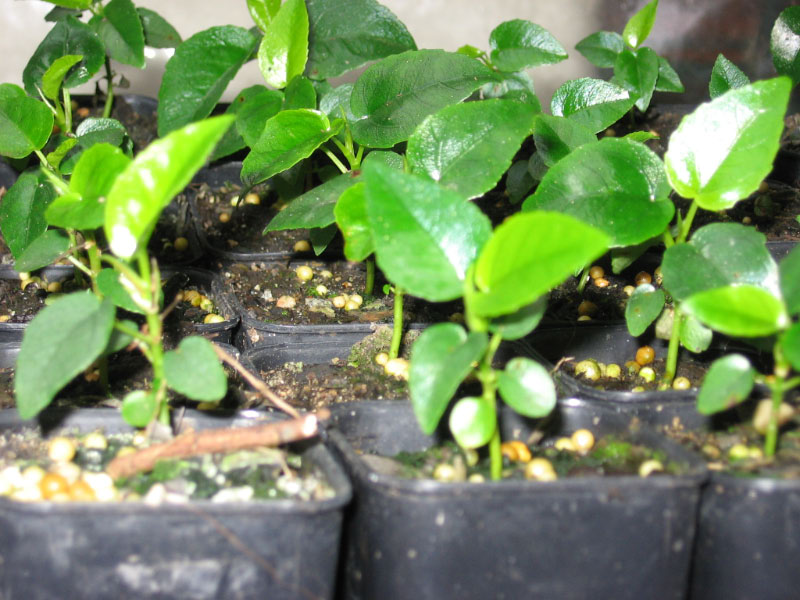
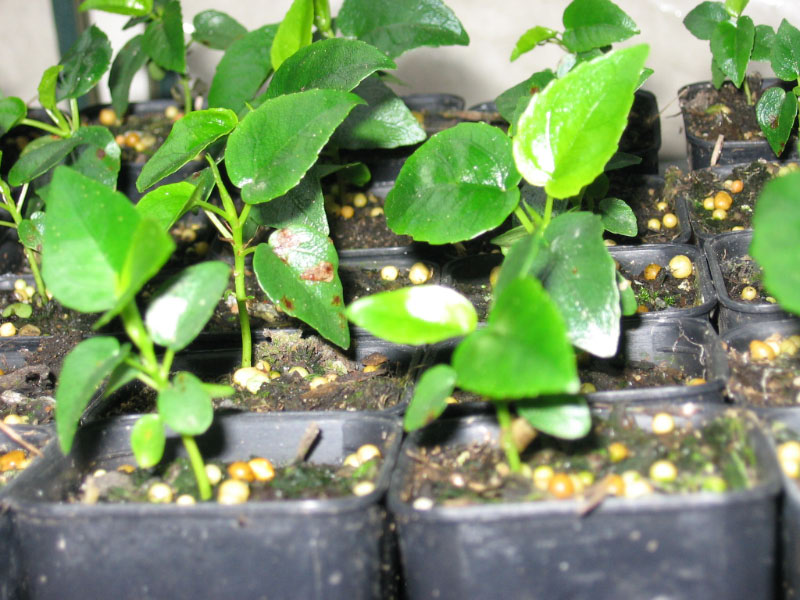
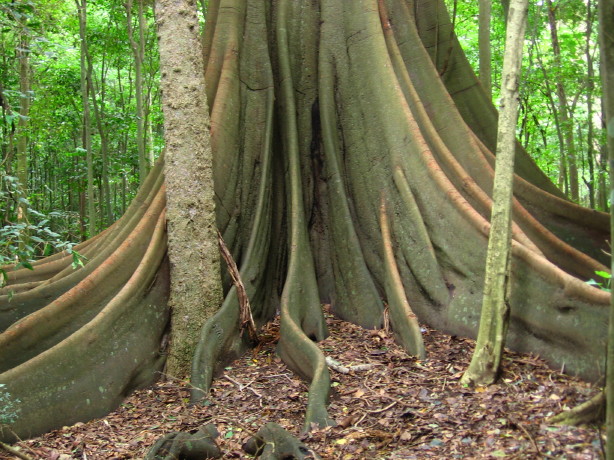
And this the mother of the seedlings above. If you ever get to Wingham visit the Wingham Brush, look for the tree with a bench seat underneath it, then look up, but only if your neck is healthy and your balance is ok. Not the largest of the figs in the Brush by a long way but the canopy is still huge.
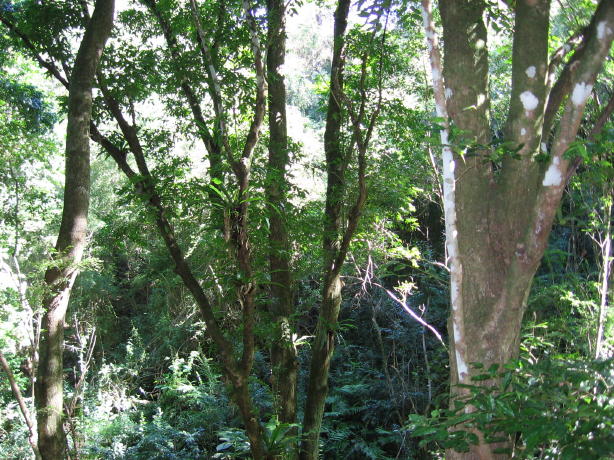

Sassafras